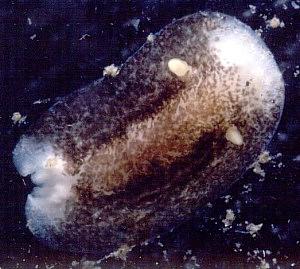
Loy thompsoni
(Millen & Nybakken, 1991)
Order: NUDIBRANCHIA
Suborder: DORIDINA
Superfamily: ANADORIDOIDEA
Family: Corambidae
DISTRIBUTION
Alaska, British Columbia, California
PHOTO
From subtidal mudflat in Bamfield Inlet, Vancouver Island, British Columbia, Canada, depth of 7m, March 5, 1985. Approx 3mm long. [from type series]. Photo: Ron Shimek.
The animal has a flattened elongate oval shape with a wide mantle margin overhanging the head and foot. The mantle is heavily spiculate, and has a well developed median posterior notch in which are found the gills and anal papilla. The background colour of the animal is translucent white, covered with dense chocolate brown spots, except at the anterior and posterior ends. The rhinophores are pale yellow and the gills are white. At the base of the two outer gills are shiny white, paired branchial glands. The ventral surface is unpigmented. The largest specimen in the original description was 6.5mm long.
Reference:
• Martynov, A.V. (1994a) Materials for the revision of nudibranchiate molluscs of the family Corambidae (Gastropoda, Opisthobranchia) Taxonomy. Communication 1. Zoologichesky Zhurnal, 73(10): 3-14.
• Martynov, A.V. (1994b) Materials for revision of nudibranch molluscs of the family Corambidae (Gastropoda, Opisthobranchia). Part 2. The origin. Zoologichesky Zhurnal, 73(11): 36-43.
• Martynov, A.V. (1995) Materials for the Revision of the Nudibranch Family Corambidae (Gastropoda, Opisthobranchia). Communication 2. Origin of the Corambidae. Hydrobiological Journal, 31(7): 59-67.[In English. Originally published in Zoologichesky Zhurnal, 73(11)]
• Millen, S.V. & Nybakken, J. (1991). A new species of Corambe (Nudibranchia: Doridoidea) from the northeastern Pacific. Journal of Molluscan Studies, 57 (supplement): 209-215
• Valdes, Angel, & P. Bouchet. (1998) A blind abyssal Corambidae (Mollusca, Nudibranchia) from the Norwegian Sea, with a reevaluation of the systematics of the family. Sarsia, 83(1): 15-20.
Rudman, W.B., 2003 (February 4) Loy thompsoni (Millen & Nybakken, 1991). [In] Sea Slug Forum. Australian Museum, Sydney. Available from http://www.seaslugforum.net/find/loythom
Related messages
Loy thompsoni - more photos
September 16, 2003
From: Ron Shimek
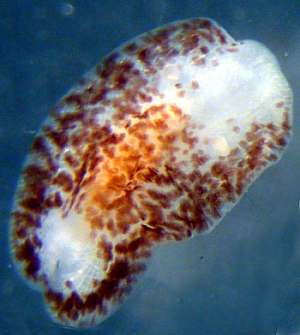
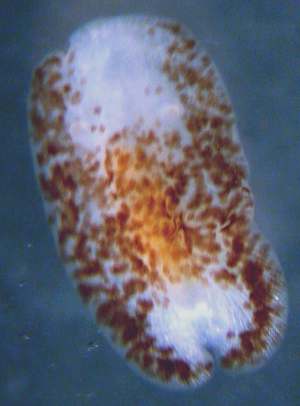
Hi Bill,
Here are a couple of more images of Loy thompsoni from Bamfield, British Columbia, [Canada]. The animal was found in a sea table at the Bamfield Marine Science Centre this last summer during an Invertebrate Zoology class I was teaching at the time. The animal was about 3-4 mm long.
Ron Shimek
rshimek@imt.net
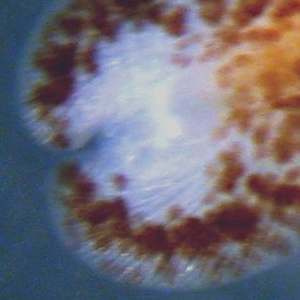
Thanks Ron,
I have included a closeup here of the posterior end of the mantle as it shows the heavy spiculation of the mantle very well
Best wishes
Bill Rudman
Loy thompsoni from Alaska
May 8, 2003
From: Nora Foster
Hello from Alaska.
I just blundered into this site when looking for information on "Corambe sp." I was shown samples, appparently this or a close species from Bristol Bay, Alaska - on soft sand sediments, probably ca. 50 m. Thay're small, but similar to the specimens I examined several years age from Prince William Sound (Port Valdez). If anyone has comments or would like to arrange a loan to examine the specimens, please contact me. I'd also be interested in obtaining reprints on this and related species.
Thanks
Nora Foster
fyaqua@uaf.edu
Foster, N., 2003 (May 8) Loy thompsoni from Alaska. [Message in] Sea Slug Forum. Australian Museum, Sydney. Available from http://www.seaslugforum.net/find/9878Thanks Nora
I don't suppose you have photos of the living animal?
Cheers,
Bill Rudman
Re: Corambe thompsoni from British Columbia
February 13, 2003
From: Dave Behrens
Bill:
I understand that Martynov (1994a) reassigned the species to the genus Psammodoris. Then Valdés and Bouchet (1998) in their reorganization of Corambids have now placed it in the genus Loy Martynov, 1994.
Additionally we have recorded the species from Port Valdez, Alaska (Nora Foster, pers. comm.)
Dave Behrens
dave@seachallengers.com
Dear Dave,
Thanks for reminding me of Martynov's publications which I have listed below. I am happy to follow Valdés & Bouchet, which means I should transfer Doridella sp. to Corambe
References:
• Martynov,A.V. (1994a) Materials for the revision of nudibranchiate molluscs of the family Corambidae (Gastropoda, Opisthobranchia) Taxonomy. Communication 1. Zoologichesky Zhurnal, 73(10): 3-14.
• Martynov,A.V. (1994b) Materials for revision of nudibranch molluscs of the family Corambidae (Gastropoda, Opisthobranchia). Part 2. The origin. Zoologichesky Zhurnal, 73(11): 36-43.
• Martynov, A.V. (1995) Materials for the Revision of the Nudibranch Family Corambidae (Gastropoda, Opisthobranchia). Communication 2. Origin of the Corambidae. Hydrobiological Journal, 31(7): 59-67.[In English. Originally published in Zoologichesky Zhurnal, 73(11)]
• Valdes, Angel, & P. Bouchet. (1998) A blind abyssal Corambidae (Mollusca,
Nudibranchia) from the Norwegian Sea, with a reevaluation of the systematics of
the family. Sarsia, 83(1): 15-20.
Corambe thompsoni from British Columbia
February 11, 2003
From: Ronald L. Shimek

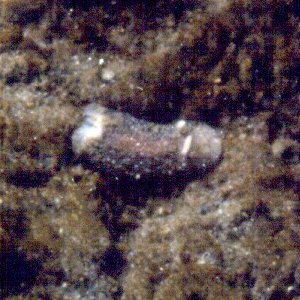
Hi Bill,
Here are two images are of Corambe thompsoni. The same individual (one of the animals used in the description of the species) is in both images. The animal is about 3mm long. One image shows a bit of the habitat; this specimen was collected on a subtidal mudflat in Bamfield Inlet, Vancouver Island, British Columbia, Canada, at a depth of 7m, March 5, 1985. There was a lot of organic debris (bark and algal fragments, etc) in the area and the nudibranch was quite cryptic. The substrate was very silty sand. The second image shows the animal in a close-up shot taken in the lab.
Hope these will work for you.
Cheers,
Ron
rshimek@imt.net
Shimek, R., 2003 (Feb 11) Corambe thompsoni from British Columbia. [Message in] Sea Slug Forum. Australian Museum, Sydney. Available from http://www.seaslugforum.net/find/9169Thanks Ron,
This is an interesting addition to the Forum and differs from othr members of the family which tend to have prominent white network on their mantle to mimic the bryozoan colonies they feed on.
Best wishes,
Bill Rudman
